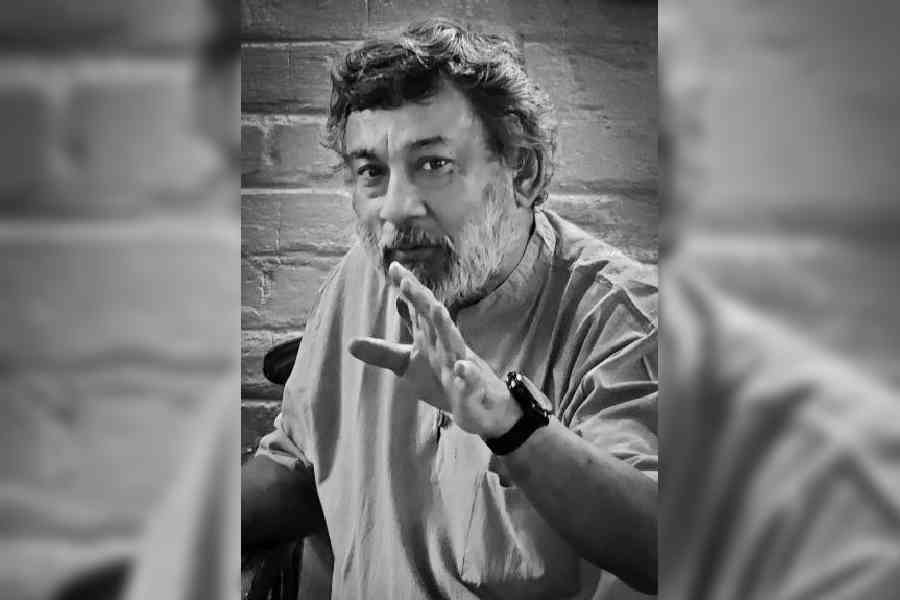Rows upon rows of thatched houses on the slope of a hill. Not a single tin roof, lamp post or electric cable sticking out like a sore thumb in this prelapsarian domain. The interiors of the houses of chieftains are embellished with human skulls and giant wood carvings of naked males in a state of arousal, copulating couples and tigers and the giant beaks of hornbills.
Pointing at the images, Pablo Bartholomew says: “This is visual anthropology. All these photographs were taken 30 years ago. I was there at the cusp when change was taking place”.
Bartholomew’s exhibition on an epic scale titled “The Nagas” is now on at the Birla Academy of Art & Culture, and he was here for the opening last Saturday.
Bartholomew is identified with his heartbreaking images of the Bhopal gas tragedy, his visual reportage of the destruction of the Babri Masjid and the anti-Sikh riots.
This is the 14th exhibition of “The Nagas” and here the photographs are being displayed along with textiles and giant wooden objects such as carvings — perhaps parts of larger pieces — and beds used by Nagas. It is on till December 15.
Till now “exhibitions have been the main medium to communicate”, but now Bartholomew will make more books.
The large prints are in warm and vibrant shades that perfectly reproduce flesh tones. This was before digital photography and Bartholomew used slow speed 50 ASA and 100 ASA film which has “very fine grain”. These colour slides were scanned for the brilliant prints.
The exhibition is an elegy to the passing of an animist culture and certain social practices deemed primitive today that got wiped out with the advent of Christianity and the attendant modernity inherited from the West. The security forces’ anti-insurgency operations in the 1950s and 1960s, too, devastated their lives.
The head hunter — almost every inch of his face and body tattooed — in an elaborate headdress that is sharply in contrast with his loincloth blows a buffalo horn, while the other men of the village work up a frenzy as they beat the newly installed log drum to celebrate the annual spring festival. The log drum is installed every 30 years or so when the old one ages and starts to break. Villagers are busy working in the farms on the slopes of hills. The hills echo their joyous harvest songs.
The two proud spear-toting wives of a chief are richly adorned with heavy, thick coils of colourful bead necklaces that only partly conceal their bare breasts. The young daughter-in-law standing behind them, however, is fully covered. “This is the generational gap”, says Bartholomew.
Is this art photography or documentation? “The lines in photography are blurred these days. My black-and-white photographs are being shown at the Barbican in London,” Bartholomew explains.
He photographed the Naga tribes for over 10 years — from 1989 to 2000 — and in his curatorial notes he described it as “an adventure in very difficult and trying terrain” in Assam, Nagaland, Manipur and Arunachal Pradesh, occasionally close to the Myanmarese border.
His vehicle was a Maruti Gypsy that doubled as his portable photo studio, carrier of photographic equipment and a generator as well as his bed. His father, Richard Batholomew, a pioneering art critic and artist, had along with his family fled Myanmar when the Japanese were bombing the country during World War II.
There are several images of modern-day Nagas as well. There is a telling one of paper lantern stars shining in the dark as Kohima celebrated Christmas. Children playfully pretending to be part of a rock band are in a living room with sofas in the company of their young aunt. She is in pants.
A young woman tries on her white bridal gown. Children from a youth choir in bright yellow sing on the Kohima parade ground. Lissome young women in smart modern versions of traditional wear pose for shoots as they would in a studio. Now young people would rather take up desk jobs than be engaged in manual labour.
The incarnadine world of headhunters has been swept away by a wave of modern lifestyles and conveniences.
“Everything is around heads. A man who took heads would gain strength and fertility for himself and, by extension, his family and the larger block of his home and village,” says Pablo Bartholomew. It was “very visual” and the number of heads taken by a man would be represented in their neckpieces.
In certain cultures, the skull was a powerful source of life and fertility. “Everything is very raw and organic. No in-between.”
“The Nagas” belonged to a time when humans were in a state of nature. But the lure of urban life was difficult to resist. As in the case of many other ancient cultures that have become obsolete, the old ways will only survive in memories and archives.










